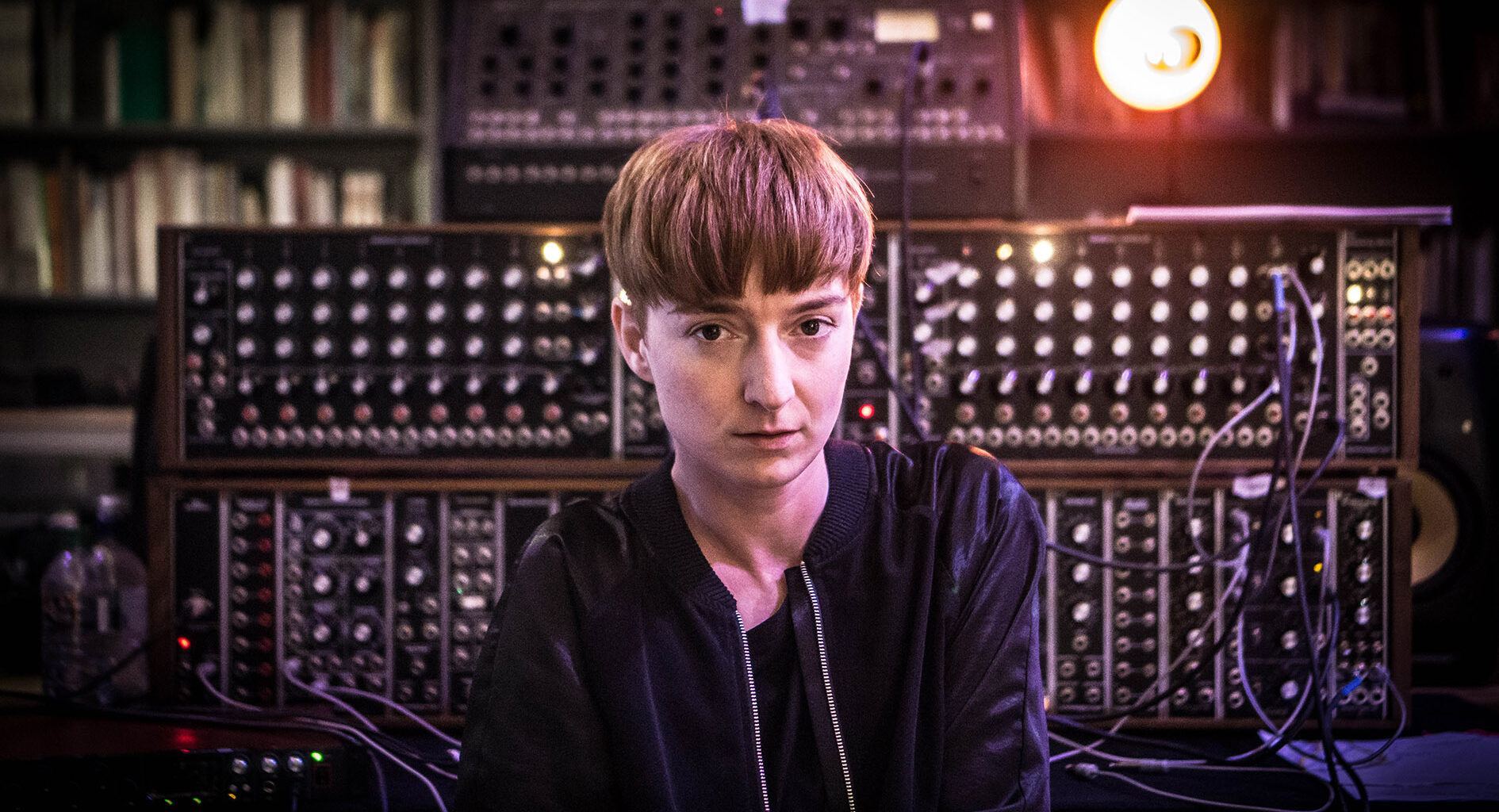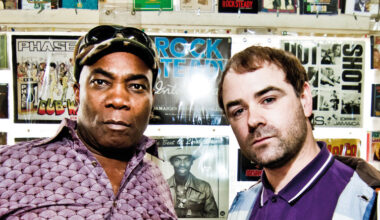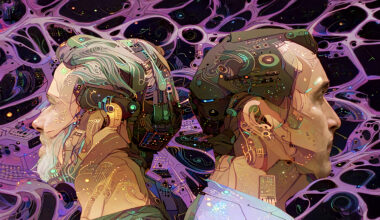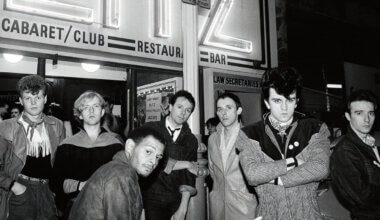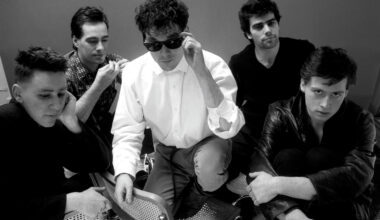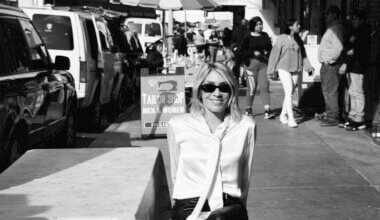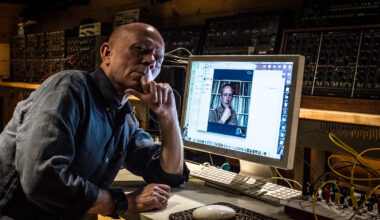Post-punky songstress Lonelady experienced a Zen-like moment when she hooked up with vintage electronic trio Wrangler during her week-long residency at the Barbican in London. The end result? Analogue heaven
This is very bizarre. In a corner of the Barbican Centre in London, sectioned between the building’s cold grey exterior, a girl is sitting in a perspex box. She’s here as an artist-in-residence at Doug Aitken’s month-long ‘Station To Station’ living project, first established in 2013 to explore modern creativity by enlisting a variety of cross-collaborators based in major cities spread across the globe. The girl is from Manchester and her name is Julie Campbell, but she’s better known as LoneLady.
Surrounded by the tools of her trade, LoneLady has spent the last week in her box recording a track called ‘Fear Colours’ for the A-side of a vinyl-only 12-inch single to be released via The Vinyl Factory, who have installed a mobile pressing facility in a nearby workshop. The flip of the record features a remix of ‘Fear Colours’ by Stephen Mallinder, one-time Cabaret Voltaire frontman and now a key member of the innovative electronic trio Wrangler.
Despite almost universal acclaim for ‘Hinterland’, her second LoneLady album for Warp, Julie Campbell is always looking to experiment and assimilate new ideas. She’s currently getting a little obsessed about integrating more analogue hardware into her thrusting, guitars-meet-synths, post-punk influenced electronic sound. Which is why she has been steered towards Mallinder’s fellow Wrangler member Benge, who has kindly loaned her a Moog Format Modular synth for her week at the Barbican. LoneLady’s residency is set to end with her sharing a live stage with Wrangler, but how did this union come about?
“Their manager got in touch with me and we started a conversation,” says Julie, matter-of-factly. “I was very pleased because I love Wrangler’s music and I’m also a huge Cabaret Voltaire fan. I think Wrangler and LoneLady have quite a lot of contrast actually, which will add something to the live event rather than just having another version of me playing. They bring something really different to the table, but there is a crossover with our mutual interest in rhythm. Plus Benge is teaching me a bit about the modular synth world, which is something I’m hoping to pursue further. Benge gave me a quick tutorial on the Moog Format Modular, which was brilliant, but since then I’ve been exploring it on my own during the week.”
What did you learn from spending so much time toiling with the complex-looking patch-based system?
“I think the main thing was not to be so uptight about needing an end product and just allowing there to be a happening. I want to work with more hardware, but it’s quite difficult to get your hands on this old modular synth gear because it’s expensive and it’s cumbersome. So this was a really nice opportunity for me to spend a bit of time with one of those machines, just to see if I got along with it, which I think l I did. I just like the tactile quality of dials and faders and patch leads; all that stuff works in my head and I think it makes what I’m doing sound better. I’m going to be sorry to see Benge take it back again!”
How did it feel to be on public display in the perspex box?
“I’ve just been trying to do what I do, but the fish tank scenario was quite strange. Every time somebody came to watch what I was doing and put the headphones on to have a listen, I felt like I had to make sure there was some sort of sound there for them to hear, which really pushed me out of my comfort zone.”
Listening to ‘Hinterland’, it’s obvious that LoneLady’s obsession with electronics has gradually become integral to her sound, albeit never at the expense of her more traditional use of instruments. But it seems that her initial interest in electronic music pre-dates her love of guitars.
“I’ve always enjoyed electronic music,” notes Julie. “In fact, I had a keyboard before I had a guitar. What has stuck with me from when I was growing up is pop music, which at that time had a lot of electronic elements as well as being very melodic and catchy. Later on, I discovered all the post-punk music from the late 70s and early 80s and I really love how synthesisers and technology were a part of that scene.
“Even my guitar influences, like Andy Gill [Gang Of Four] and Keith Levene [PiL], are people who deconstruct the guitar and don’t play it in any sort of rock ’n’ roll style. It kind of occurred to me recently that the way I’ve been playing guitar – in a percussive way – it’s almost like I’m trying to play it like a sequencer. And I have to admit I’ve got a thing about drum machines as well. I use the in-built drum machine on my really cheap Yamaha keyboard all the time. I’m kind of obsessed with trying to make drummers drum like machines.”
Those disparate elements come together effortlessly on ‘Hinterland’. Basslines coil and gyrate around spiky guitar refrains and rough, mechanical-sounding percussion. The lo-fi production is bare and gritty. The overall result sounds as though it’s been written with the intention of being replicated in a live setting as accurately as possible.
“My live set-up has changed over the two LoneLady albums,” says Julie. “When I first started playing live, it was literally just me and a drum machine, but for ‘Hinterland’ I really wanted to get across a sense of organic rhythm and also a bit more warmth. I wanted the audience to see people hitting drum pads and tweaking dials, to see them actually generating the sounds, so the laptop approach was never going to be right for me. There are four of us on stage now and I think having more people up there has really helped in getting the groove across. It’s also good for me to look around and see a few more musicians alongside me.
“I wouldn’t say it is necessary for me to be able to replicate the album live, because that would rely on too much playback and I’d find that a bit sterile. I mean, it took a while for me to figure out how we were going to play live. I did have an Akai sampler last time around, but we’ve integrated samplers more into the live set-up, so it’s been like a new language for everybody to learn.”
As much as technology plays an important role in LoneLady’s sound, the effect of the environment in which she works cannot be underestimated. While some artists put a lot of time and effort into fabricating a dystopian vision that resonates with their listeners, harsh and challenging surroundings have long been a part of Julie’s everyday existence – and that bleeds through her music with a rigid authenticity.
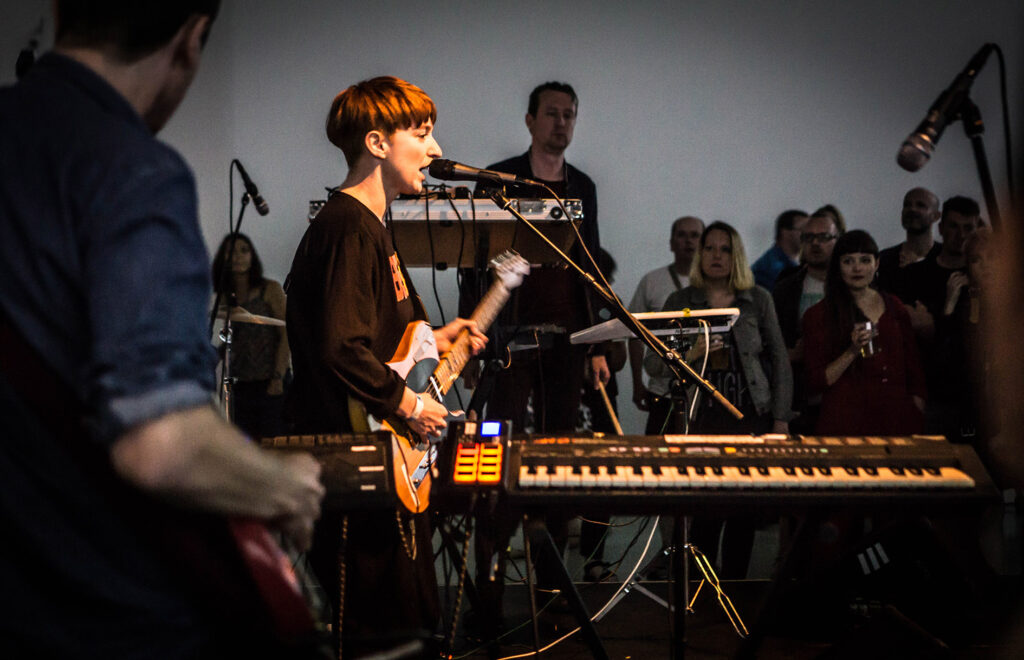
“A big part of what I take inspiration from is brutalist architecture and concrete, because I’ve lived in a tower block next to the Mancuian Way for years,” explains Julie. “That’s also where my home studio is, which I refer to as my ‘concrete retreat’. Buildings like that can often be very protective and feel like a bolthole, but they can feel like a bit of a prison cell at the same time, so I’m coming at it from both an architectural and a psychological place as well.
“I think you should always write about what you know, and within the four walls of the tower block I tend to write about materials, structures and spaces rather than people. It’s a theme that keeps underpinning everything I do, so to wind up at the Barbican, which is an iconic piece of brutalist architecture, has been a continuation of that journey in a way that makes sense and I find really pleasing.”
Do you fully embrace that environment or do you also feel the need to escape from it?
“I’m torn between the two impulses. I never planned to move into a tower block, to be surrounded by concrete, but something that’s quite bleak and functional develops a kind of beauty and language of its own over time. If you’re receptive to that, it can be quite an inspirational force and I think that’s what it is for me.”
Standing in a room propped up by a hideous six-by-six-foot block of concrete is certainly the perfect setting for an evening celebrating “brutalist architecture”. Wrangler are first to take the stage for their 40-minute live set. Stephen Mallinder and Phil Winter are hunched over two tables draped in black linen and chock-a-block with analogue toys dispensing plenty of snarling electronics. Benge completes the triangular formation, vigorously striking a pair of drum pads.
Flickering LEDs flicker across the stage as a wasteland of guttural noises and rhythmic metallic arpeggiators spring to life. Mallinder’s Dalek-esque vocals are deliciously sinister, especially on the highlight of the evening, a cover of John Foxx’s ‘He’s A Liquid’. The green shapeshifting patterns on the video screens that surround the packed hall of onlookers are replaced by the slogan “Retreat or Danger” shortly after Wrangler’s performance comes to a close.
“Have you heard of a book called ‘Bunker Archeology’ by Paul Virilio?” asks Julie as she waits in the wings. “He explored all these defunct military bunkers and reimagined them as mysterious forms. The bunker thing ties in with where I live in my concrete tower block in Manchester and that’s what ‘Retreat or Danger’ refers to.”
The four-piece LoneLady live group take their places on a minimally lit stage. Splayed guitar notes break the silence as electronic drum patterns collide with tribal percussion. Dressed in black and with a guitar slung over her shoulder, the slightly built Julie Campbell drills her way through a powerful, edgy set without pausing for breath. The audience slowly envelops the stage, becoming increasingly animated in tandem with the band’s frequent bursts of kinetic post-punk energy, the judicious use of analogue gear burning into their membranes.
In the aftermath of the gig, Julie talks about another collaboration between LoneLady and Wrangler coming down the pipe. As well as Stephen Mallinder’s remix of ‘Fear Colours’, the two acts have been writing together and the results should see the light of day after Wrangler have released their upcoming modular remix album, ‘Sparked’, which will feature reworkings from their ‘LA Spark’ debut. Julie is clearly excited by the fruits of their joint labour.
“We’ve got some great material and it’s now a question of finding the time in everyone’s schedule to finish it off and decide how we want to present it. The process has been very modern so far, I’m afraid, with Benge generating the sequences and getting a bunch of grooves going, which he then sent to me to put loads of guitar over. All we need now is some finishing contribution from Phil and Stephen!”
Remember that you read it here first, folks.
Benge On Working With Lonelady
“I first got involved with this Barbican project through the modular synths. LoneLady wanted to use some real analogue modulars while she was here, to get a few more sounds into her palette as it were, and she approached me to bring along a Moog Format Modular synth. It’s a bit of a monster, so I set it up for her and showed her how it worked.
“The Moog Format Modular is actually quite a modern system, but it’s based on a design from the 1960s. It’s essentially a couple of oscillators, filters and sequencers. There’s no keyboard and I decided not bring one with me because it makes you approach the instrument in a completely different way. I set up a giant patch on it, which is essentially a three-part drum machine and bassline sequencer that all syncs together. You can create a whole track from that one patch, but the modular does have a MIDI interface so you can clock it directly from your computer.
“On top of it, we’ve got an old 1970s Korg Modular MS-50. It’s a really rare one, but it uses all the same voltages and connectors. One of the things about modular synths is that one system often won’t work with another, so if you’re using modular you need to be able to put stuff together that all works happily. The MS-50 was designed to be an updated version of the Moog and its purpose was to continue the Moog legacy into the future. It’s kind of equivalent to a big Eurorack system and they’re really not that expensive.”
A Fistful Of Gear: The Live Set-Ups
Lonelady
“Gareth Smith is at the master station,” says Julie Campbell. “He uses an MPC500 for beats and the new Akai MPX8, which is really user-friendly, but I think we need something a bit more hard-wearing for the road. He also has an Alesis reverb unit put through a Mackie mixer. Running from that, we’ve got the two drum pads and a Roland SPD-20 Octapad, and a lot of sounds come off that as well.
“On the other side of the stage, Tom Long has an old Simmons SDMP1 drum pad, which is a bit wonky but sounds great, and my old Yamaha PSR2. Its bank of instruments is pretty unsophisticated and it’s really wobbly. It’s like a kind of ‘Sesame Street’ version of a keyboard.”
Wrangler
“I have a really minimal set up,” says Benge. “The drums are made by Nord and the sound is based on a Simmons from the 1980s. I run backing tracks of the sequenced stuff using Digital Performer, but all the original sequenced material is done with modular synths and vintage gear.
“Phil uses an Arturia MiniBrute and it’s awesome – really crispy, sharp oscillators and envelopes, and with a great filter on it. The Boss Chromatic Tuner TU-3 is essential and he’s also got an electro harmonic phaser/flanger thing called a Worm.
“Mal does lots of vocal manipulation through the Korg Kaoss Pad and a Roland voice processor. He then goes straight from the mic into a Roland Voice Transformer and out to the Kaoss Pad, so you’re doubling up the effects. We’ve also got a microKORG, which is a tacky little thing but really light so it’s great for sticking in hand luggage. We nicked that off John Foxx, but don’t tell him.”
When Things Go Random!
Lonelady
“It was a specific decision of mine to use older gear. I just think it sounds better and it’s part of that whole aesthetic that I’m quite drawn to. But that does mean that every show I play presents its challenges – and the more old electronic gear I acquire, the more uncertainties there are going to be.
“I think there are more technical problems now that we’ve got samplers and old drum pads in the mix. They’re constantly glitching or failing or just generally acting strangely. It’s sort of part of their charm, but it can be maddening as well. Something I’ve realised is that you can never get the levels perfect. We have continual issues with the vocoder sample, for instance. It’s boomingly loud at some venues, but then it just doesn’t cut through at all when we play other places.”
Benge
“It’s all part of the fun really. If everything was always perfect, it wouldn’t be interesting. Obviously things breaking down and stopping isn’t a good thing, but it doesn’t happen that often. It makes it more exciting on stage and it can even sometimes sound better as well, especially through a big PA system.
“We did a gig with John Foxx at The Roundhouse in London and took along a load of vintage modular gear and tape machines. That was really mental, because we also connected things together with CV/gate, which is a pre-MIDI system for hooking stuff up. It is actually quite tight and reliable, but it’s still 1970s technology. The usual sort of things went wrong, especially gear not triggering properly. We did have back-ups of everything and various ways of getting ourselves out of trouble, but it was a risk because it was in front of quite a lot of people on a massive stage.”
